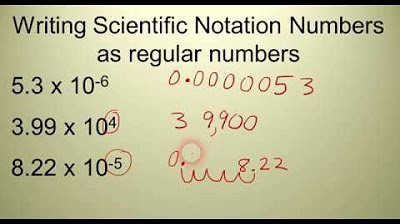Scientific Notation - Fast Review!
Summary
TLDRThis lesson offers a fundamental guide to scientific notation, ideal for expressing both very large and minute numbers. The instructor demonstrates converting numbers like 45,000 and 9.3 billion into scientific form, emphasizing the significance of positive and negative exponents. Examples are provided for converting both large and small numbers to scientific notation and vice versa, illustrating how shifting the decimal point left or right affects the exponent's sign. The tutorial aims to make the process of converting between scientific and standard notation clear and accessible.
Takeaways
- 🔢 Scientific notation is a method to express very large or very small numbers compactly.
- 📐 To convert a large number to scientific notation, move the decimal point to the right of the first non-zero digit and count the number of places moved to determine the exponent.
- 🔄 For large numbers, the exponent in scientific notation is positive, indicating the number is scaled up.
- 🔎 For small numbers, move the decimal point to the right to place it between the first and second significant digits, then count the moves to determine a negative exponent.
- 📉 A negative exponent in scientific notation indicates a very small number, less than one.
- 🔄 To convert scientific notation back to standard form, move the decimal point to the right for positive exponents and to the left for negative exponents by the number of places indicated by the exponent.
- 📘 The exponent in scientific notation is a power of 10, which scales the number in front of it (the coefficient) up or down.
- 📋 Examples given include converting 45,000 to 4.5 × 10^4, 37,580,000 to 3.758 × 10^7, and 0.0023 to 2.3 × 10^-3.
- 🔠 The coefficient in scientific notation should be a number between 1 and 10 for non-zero values.
- 🔄 Moving the decimal point to the right increases the value of the number, while moving it to the left decreases it when converting between scientific and standard notation.
Q & A
What is scientific notation?
-Scientific notation is a way to express very large or very small numbers in a compact form. It uses a base number between 1 and 10 multiplied by a power of 10.
How do you express the number 45,000 in scientific notation?
-The number 45,000 is expressed in scientific notation as 4.5 x 10^4, by moving the decimal point four places to the left.
What does a positive exponent in scientific notation represent?
-A positive exponent in scientific notation represents a very large number. It indicates how many places the decimal point must be moved to the right to return to the original number.
Can you provide an example of converting a large number to scientific notation?
-Yes, the number 375,580,000 can be converted to scientific notation as 3.7558 x 10^8 by moving the decimal point eight places to the left.
How is the number 9.3 billion expressed in scientific notation?
-9.3 billion is expressed as 9.3 x 10^9 in scientific notation, by moving the decimal point nine places to the left.
What does a negative exponent signify in scientific notation?
-A negative exponent signifies a very small number, or a number less than 1. It indicates how many places the decimal point must be moved to the right to return to the original number.
How do you convert the number 0.0023 to scientific notation?
-The number 0.0023 is converted to scientific notation as 2.3 x 10^-3 by moving the decimal point three places to the right.
What is the process of converting a number from scientific notation to standard notation?
-To convert from scientific notation to standard notation, you move the decimal point to the right for positive exponents and to the left for negative exponents, the number of places indicated by the exponent.
Can you give an example of converting a number with a negative exponent from scientific notation to standard notation?
-Yes, the number 2.4 x 10^-2 in scientific notation converts to 0.024 in standard notation by moving the decimal point two places to the left.
How do you determine whether to move the decimal point to the left or right when converting to scientific notation?
-You move the decimal point to the left for large numbers (positive exponent) and to the right for small numbers (negative exponent) to position it between the first non-zero digits.
What is the significance of the exponent in scientific notation?
-The exponent in scientific notation indicates the number of places the decimal point has been moved to reach its new position, which corresponds to the scale of the number.
Outlines

このセクションは有料ユーザー限定です。 アクセスするには、アップグレードをお願いします。
今すぐアップグレードMindmap

このセクションは有料ユーザー限定です。 アクセスするには、アップグレードをお願いします。
今すぐアップグレードKeywords

このセクションは有料ユーザー限定です。 アクセスするには、アップグレードをお願いします。
今すぐアップグレードHighlights

このセクションは有料ユーザー限定です。 アクセスするには、アップグレードをお願いします。
今すぐアップグレードTranscripts

このセクションは有料ユーザー限定です。 アクセスするには、アップグレードをお願いします。
今すぐアップグレード5.0 / 5 (0 votes)






